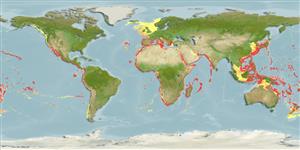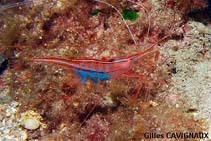Plesionika narval (Fabricius, 1787)
Narwal shrimp| Native range | All suitable habitat | Point map | Year 2050 |

|
| This map was computer-generated and has not yet been reviewed. |
| Plesionika narval AquaMaps Data sources: GBIF OBIS |
Classification / Names Common names | Synonyms | CoL | ITIS | WoRMS
Malacostraca | Decapoda | Pandalidae
Environment: milieu / climate zone / depth range / distribution range Ecology
Benthic; depth range 10 - 910 m (Ref. 434), usually 200 - 400 m (Ref. 434). Subtropical
Distribution Countries | FAO areas | Ecosystems | Occurrences | Introductions
Indo-Pacific, Atlantic Ocean and the Mediterranean: throughout the area including Madeira and Canary Islands, northward extending into the Mediterranean to the Azores, and southward extending to Angola.
Length at first maturity / Size / Weight / Age
Maturity: Lm 1.5 range ? - ? cm Max length : 14.5 cm TL male/unsexed; (Ref. 434)
Maximum depth from Ref. 102668. Benthic adults inhabiting mud or muddy sand bottoms, often near rocky areas of the continental slope (Ref. 343). Also found in submarine caves (Ref. 102668). Occurs at depths of 10 to 900 m, common between 200 and 400 m. Pelagic juveniles (Ref. 343). Has a diversified diet. Mainly a predator of benthic species; may be an occasional scavenger (Ref. 102668).
Life cycle and mating behavior Maturity | Reproduction | Spawning | Eggs | Fecundity | Larvae
Members of the order Decapoda are mostly gonochoric. Mating behavior: Precopulatory courtship ritual is common (through olfactory and tactile cues); usually indirect sperm transfer.
Main reference
References | Coordinator | Collaborators
Fischer, W., G. Bianchi and W.B. Scott (eds.). 1981. (Ref. 434)
IUCN Red List Status (Ref. 130435)
CITES status (Ref. 108899)
Not Evaluated
CMS (Ref. 116361)
Not Evaluated
Threat to humans
Human uses
Fisheries: commercial
| FishSource | Sea Around Us
Tools
More information
Internet sources
BHL | BOLD Systems | CISTI | DiscoverLife | FAO(Publication : search) | Fishipedia | GenBank (genome, nucleotide) | GloBI | Gomexsi | Google Books | Google Scholar | Google | PubMed | Tree of Life | Wikipedia (Go, Search) | Zoological Record
Estimates based on models
Preferred temperature
(Ref. 115969): 8 - 19.1, mean 13 (based on 604 cells).



